Marketing Plan Report: Beerenberg Farm Company Analysis
VerifiedAdded on 2022/11/15
|10
|1531
|228
Report
AI Summary
This report details a marketing plan for Beerenberg Farm, an Australian producer of condiments, dressings, jams, and sauces. It begins by analyzing consumer involvement, identifying the low-involvement nature of purchases due to the products' affordability. The report then outlines the stages of the buyer decision-making process, including need identification, information gathering, evaluation of alternatives, product purchase, and post-purchase evaluation. It also examines situational, psychological, and social influences on buying decisions. A key focus is on market segmentation, dividing the market into demographic, geographic, psychographic, and behavioral segments, with a detailed target market profile provided. A positioning statement is developed, highlighting the brand's value proposition, and a positioning map is included to visualize the brand's competitive landscape. The report concludes by emphasizing Beerenberg Farm's effective marketing strategies and strong market positioning in the Asia-Pacific region.
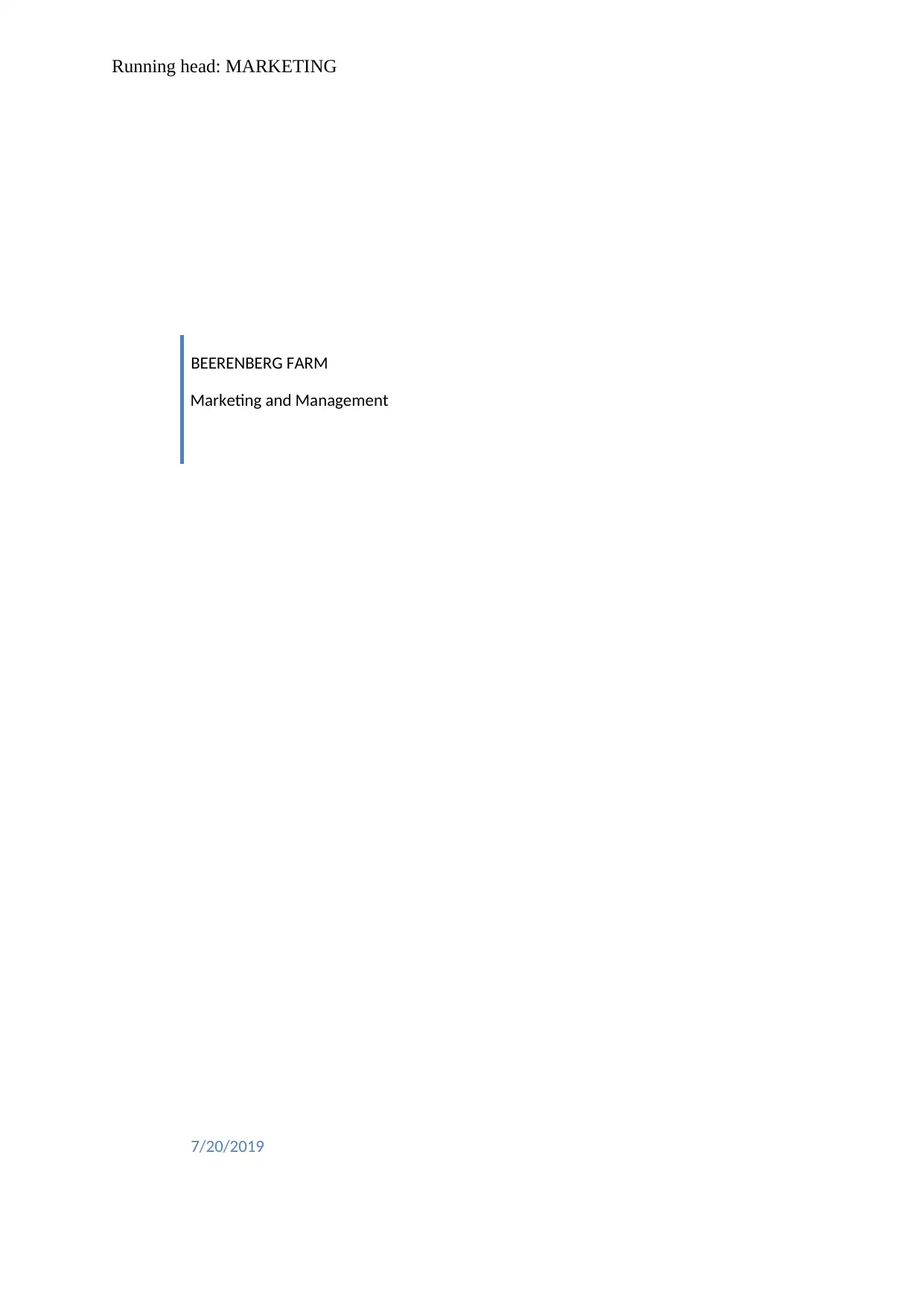
Running head: MARKETING
BEERENBERG FARM
Marketing and Management
7/20/2019
BEERENBERG FARM
Marketing and Management
7/20/2019
Paraphrase This Document
Need a fresh take? Get an instant paraphrase of this document with our AI Paraphraser
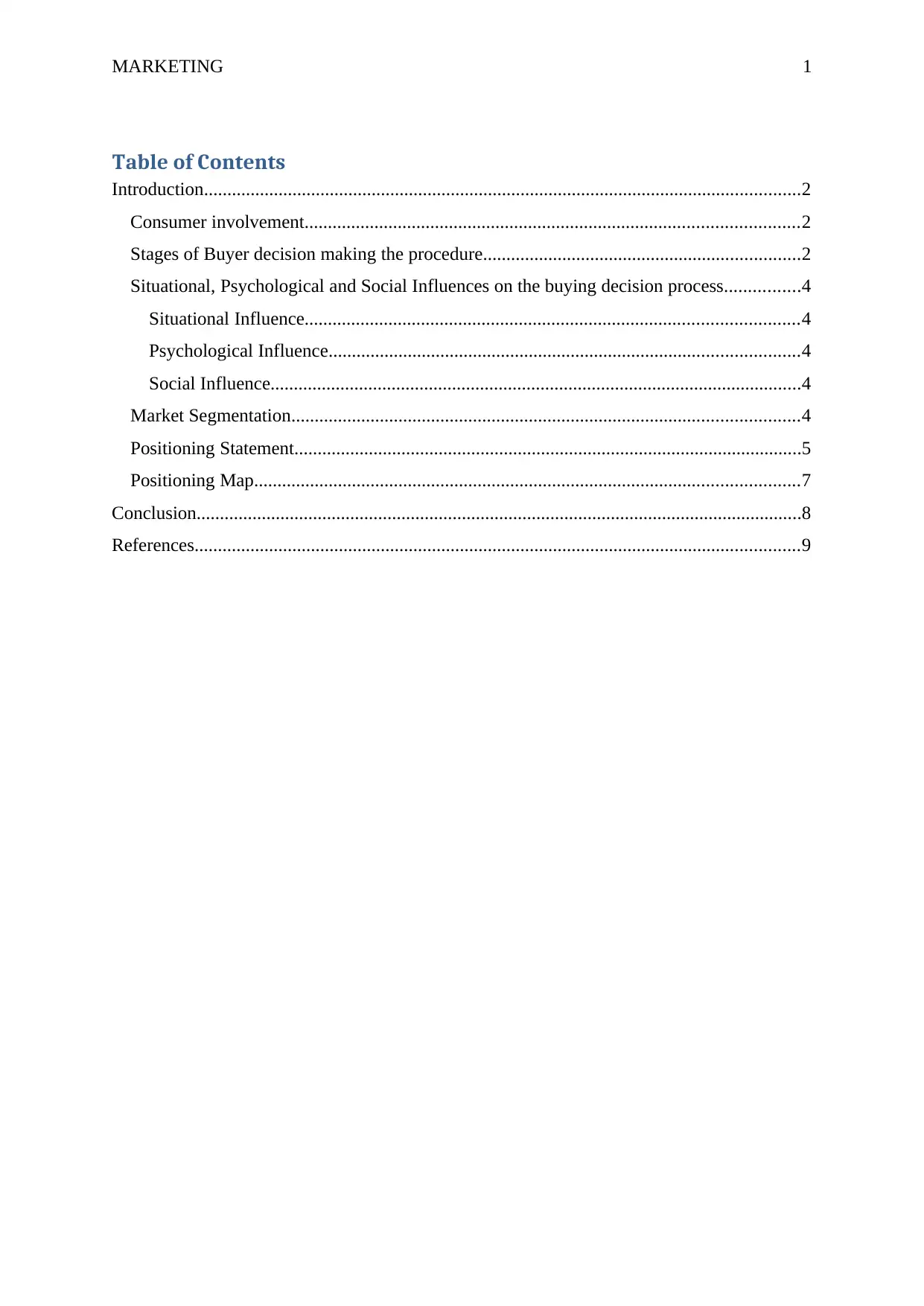
MARKETING 1
Table of Contents
Introduction................................................................................................................................2
Consumer involvement..........................................................................................................2
Stages of Buyer decision making the procedure....................................................................2
Situational, Psychological and Social Influences on the buying decision process................4
Situational Influence..........................................................................................................4
Psychological Influence.....................................................................................................4
Social Influence..................................................................................................................4
Market Segmentation.............................................................................................................4
Positioning Statement.............................................................................................................5
Positioning Map.....................................................................................................................7
Conclusion..................................................................................................................................8
References..................................................................................................................................9
Table of Contents
Introduction................................................................................................................................2
Consumer involvement..........................................................................................................2
Stages of Buyer decision making the procedure....................................................................2
Situational, Psychological and Social Influences on the buying decision process................4
Situational Influence..........................................................................................................4
Psychological Influence.....................................................................................................4
Social Influence..................................................................................................................4
Market Segmentation.............................................................................................................4
Positioning Statement.............................................................................................................5
Positioning Map.....................................................................................................................7
Conclusion..................................................................................................................................8
References..................................................................................................................................9
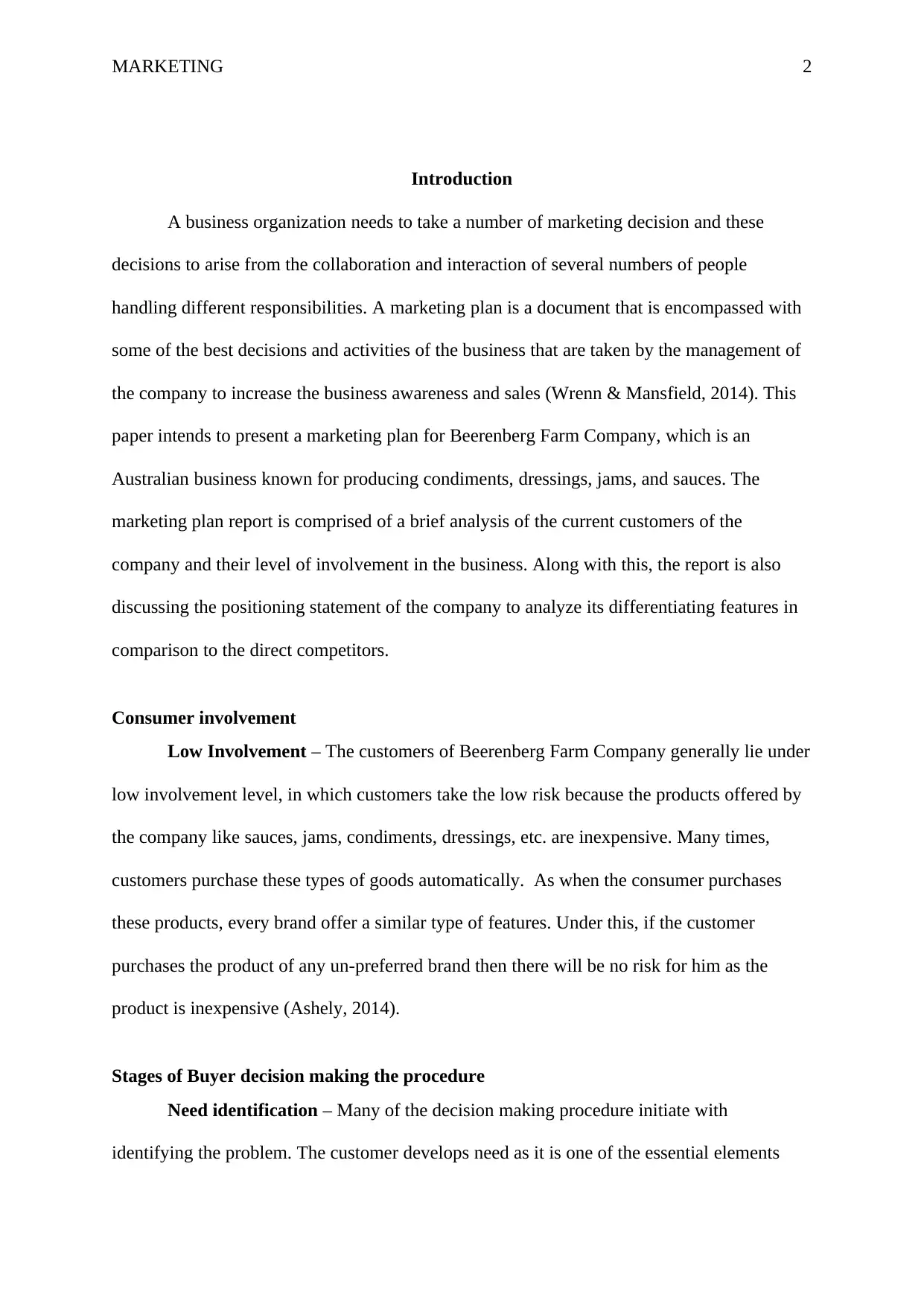
MARKETING 2
Introduction
A business organization needs to take a number of marketing decision and these
decisions to arise from the collaboration and interaction of several numbers of people
handling different responsibilities. A marketing plan is a document that is encompassed with
some of the best decisions and activities of the business that are taken by the management of
the company to increase the business awareness and sales (Wrenn & Mansfield, 2014). This
paper intends to present a marketing plan for Beerenberg Farm Company, which is an
Australian business known for producing condiments, dressings, jams, and sauces. The
marketing plan report is comprised of a brief analysis of the current customers of the
company and their level of involvement in the business. Along with this, the report is also
discussing the positioning statement of the company to analyze its differentiating features in
comparison to the direct competitors.
Consumer involvement
Low Involvement – The customers of Beerenberg Farm Company generally lie under
low involvement level, in which customers take the low risk because the products offered by
the company like sauces, jams, condiments, dressings, etc. are inexpensive. Many times,
customers purchase these types of goods automatically. As when the consumer purchases
these products, every brand offer a similar type of features. Under this, if the customer
purchases the product of any un-preferred brand then there will be no risk for him as the
product is inexpensive (Ashely, 2014).
Stages of Buyer decision making the procedure
Need identification – Many of the decision making procedure initiate with
identifying the problem. The customer develops need as it is one of the essential elements
Introduction
A business organization needs to take a number of marketing decision and these
decisions to arise from the collaboration and interaction of several numbers of people
handling different responsibilities. A marketing plan is a document that is encompassed with
some of the best decisions and activities of the business that are taken by the management of
the company to increase the business awareness and sales (Wrenn & Mansfield, 2014). This
paper intends to present a marketing plan for Beerenberg Farm Company, which is an
Australian business known for producing condiments, dressings, jams, and sauces. The
marketing plan report is comprised of a brief analysis of the current customers of the
company and their level of involvement in the business. Along with this, the report is also
discussing the positioning statement of the company to analyze its differentiating features in
comparison to the direct competitors.
Consumer involvement
Low Involvement – The customers of Beerenberg Farm Company generally lie under
low involvement level, in which customers take the low risk because the products offered by
the company like sauces, jams, condiments, dressings, etc. are inexpensive. Many times,
customers purchase these types of goods automatically. As when the consumer purchases
these products, every brand offer a similar type of features. Under this, if the customer
purchases the product of any un-preferred brand then there will be no risk for him as the
product is inexpensive (Ashely, 2014).
Stages of Buyer decision making the procedure
Need identification – Many of the decision making procedure initiate with
identifying the problem. The customer develops need as it is one of the essential elements
⊘ This is a preview!⊘
Do you want full access?
Subscribe today to unlock all pages.

Trusted by 1+ million students worldwide
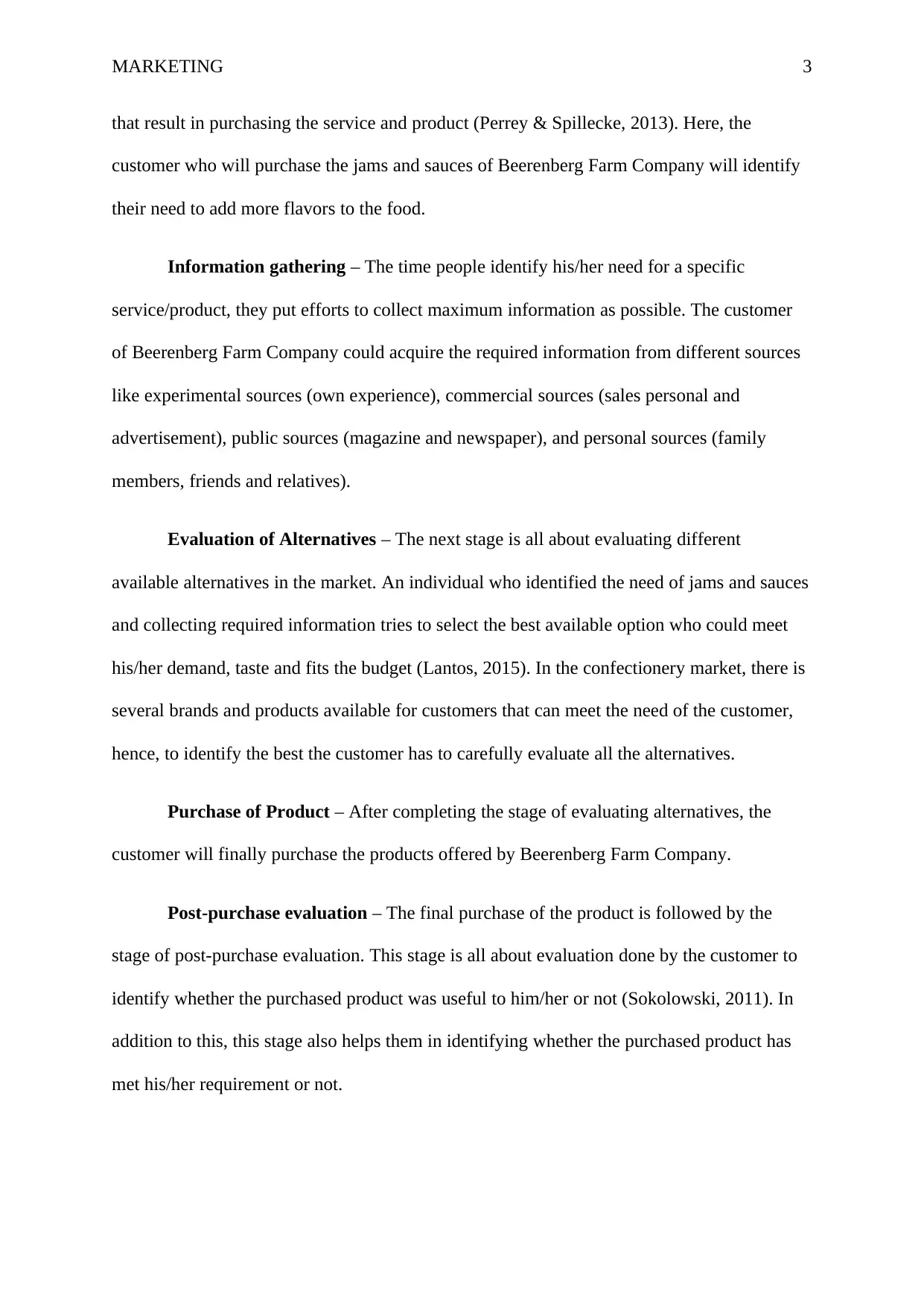
MARKETING 3
that result in purchasing the service and product (Perrey & Spillecke, 2013). Here, the
customer who will purchase the jams and sauces of Beerenberg Farm Company will identify
their need to add more flavors to the food.
Information gathering – The time people identify his/her need for a specific
service/product, they put efforts to collect maximum information as possible. The customer
of Beerenberg Farm Company could acquire the required information from different sources
like experimental sources (own experience), commercial sources (sales personal and
advertisement), public sources (magazine and newspaper), and personal sources (family
members, friends and relatives).
Evaluation of Alternatives – The next stage is all about evaluating different
available alternatives in the market. An individual who identified the need of jams and sauces
and collecting required information tries to select the best available option who could meet
his/her demand, taste and fits the budget (Lantos, 2015). In the confectionery market, there is
several brands and products available for customers that can meet the need of the customer,
hence, to identify the best the customer has to carefully evaluate all the alternatives.
Purchase of Product – After completing the stage of evaluating alternatives, the
customer will finally purchase the products offered by Beerenberg Farm Company.
Post-purchase evaluation – The final purchase of the product is followed by the
stage of post-purchase evaluation. This stage is all about evaluation done by the customer to
identify whether the purchased product was useful to him/her or not (Sokolowski, 2011). In
addition to this, this stage also helps them in identifying whether the purchased product has
met his/her requirement or not.
that result in purchasing the service and product (Perrey & Spillecke, 2013). Here, the
customer who will purchase the jams and sauces of Beerenberg Farm Company will identify
their need to add more flavors to the food.
Information gathering – The time people identify his/her need for a specific
service/product, they put efforts to collect maximum information as possible. The customer
of Beerenberg Farm Company could acquire the required information from different sources
like experimental sources (own experience), commercial sources (sales personal and
advertisement), public sources (magazine and newspaper), and personal sources (family
members, friends and relatives).
Evaluation of Alternatives – The next stage is all about evaluating different
available alternatives in the market. An individual who identified the need of jams and sauces
and collecting required information tries to select the best available option who could meet
his/her demand, taste and fits the budget (Lantos, 2015). In the confectionery market, there is
several brands and products available for customers that can meet the need of the customer,
hence, to identify the best the customer has to carefully evaluate all the alternatives.
Purchase of Product – After completing the stage of evaluating alternatives, the
customer will finally purchase the products offered by Beerenberg Farm Company.
Post-purchase evaluation – The final purchase of the product is followed by the
stage of post-purchase evaluation. This stage is all about evaluation done by the customer to
identify whether the purchased product was useful to him/her or not (Sokolowski, 2011). In
addition to this, this stage also helps them in identifying whether the purchased product has
met his/her requirement or not.
Paraphrase This Document
Need a fresh take? Get an instant paraphrase of this document with our AI Paraphraser
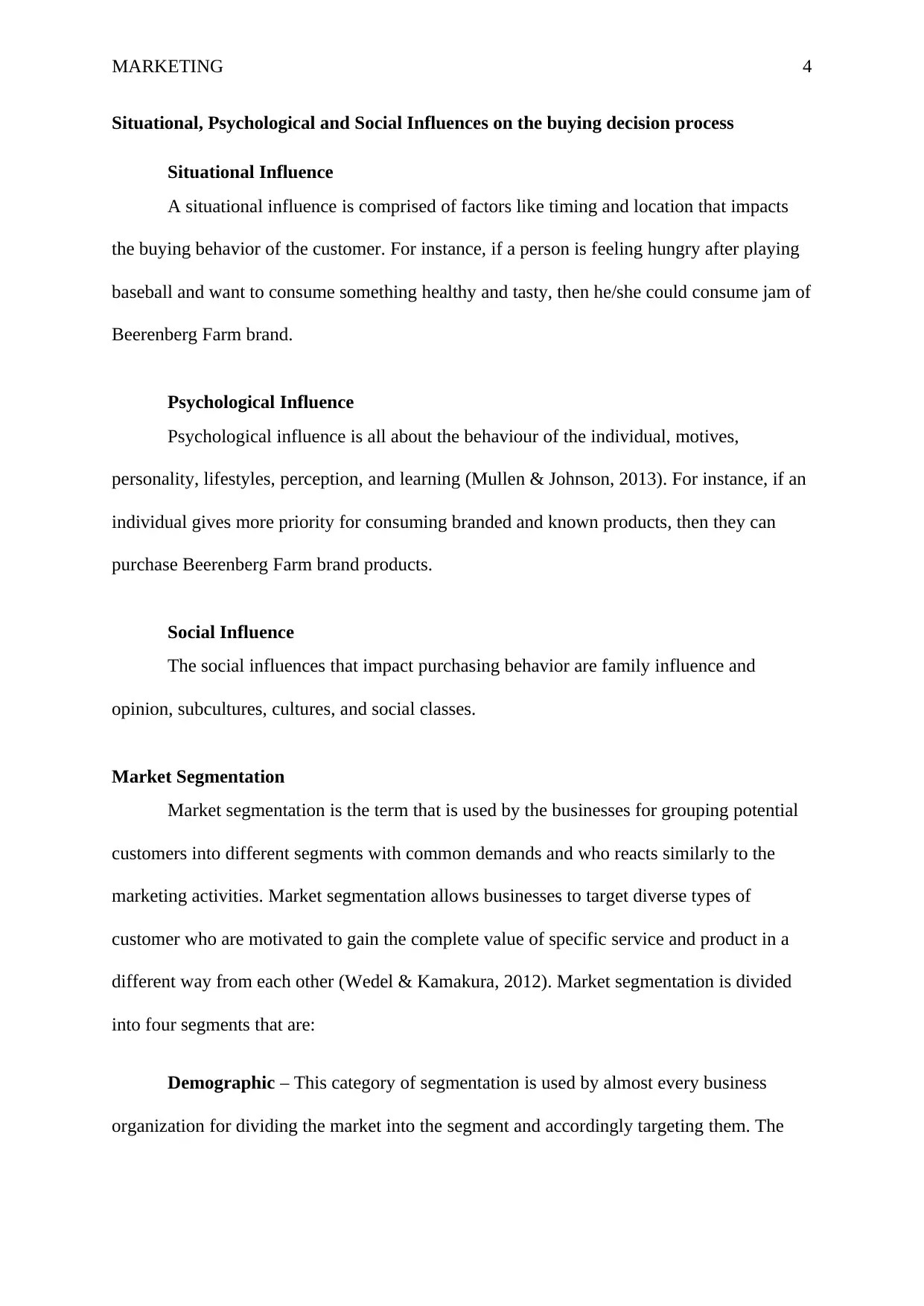
MARKETING 4
Situational, Psychological and Social Influences on the buying decision process
Situational Influence
A situational influence is comprised of factors like timing and location that impacts
the buying behavior of the customer. For instance, if a person is feeling hungry after playing
baseball and want to consume something healthy and tasty, then he/she could consume jam of
Beerenberg Farm brand.
Psychological Influence
Psychological influence is all about the behaviour of the individual, motives,
personality, lifestyles, perception, and learning (Mullen & Johnson, 2013). For instance, if an
individual gives more priority for consuming branded and known products, then they can
purchase Beerenberg Farm brand products.
Social Influence
The social influences that impact purchasing behavior are family influence and
opinion, subcultures, cultures, and social classes.
Market Segmentation
Market segmentation is the term that is used by the businesses for grouping potential
customers into different segments with common demands and who reacts similarly to the
marketing activities. Market segmentation allows businesses to target diverse types of
customer who are motivated to gain the complete value of specific service and product in a
different way from each other (Wedel & Kamakura, 2012). Market segmentation is divided
into four segments that are:
Demographic – This category of segmentation is used by almost every business
organization for dividing the market into the segment and accordingly targeting them. The
Situational, Psychological and Social Influences on the buying decision process
Situational Influence
A situational influence is comprised of factors like timing and location that impacts
the buying behavior of the customer. For instance, if a person is feeling hungry after playing
baseball and want to consume something healthy and tasty, then he/she could consume jam of
Beerenberg Farm brand.
Psychological Influence
Psychological influence is all about the behaviour of the individual, motives,
personality, lifestyles, perception, and learning (Mullen & Johnson, 2013). For instance, if an
individual gives more priority for consuming branded and known products, then they can
purchase Beerenberg Farm brand products.
Social Influence
The social influences that impact purchasing behavior are family influence and
opinion, subcultures, cultures, and social classes.
Market Segmentation
Market segmentation is the term that is used by the businesses for grouping potential
customers into different segments with common demands and who reacts similarly to the
marketing activities. Market segmentation allows businesses to target diverse types of
customer who are motivated to gain the complete value of specific service and product in a
different way from each other (Wedel & Kamakura, 2012). Market segmentation is divided
into four segments that are:
Demographic – This category of segmentation is used by almost every business
organization for dividing the market into the segment and accordingly targeting them. The
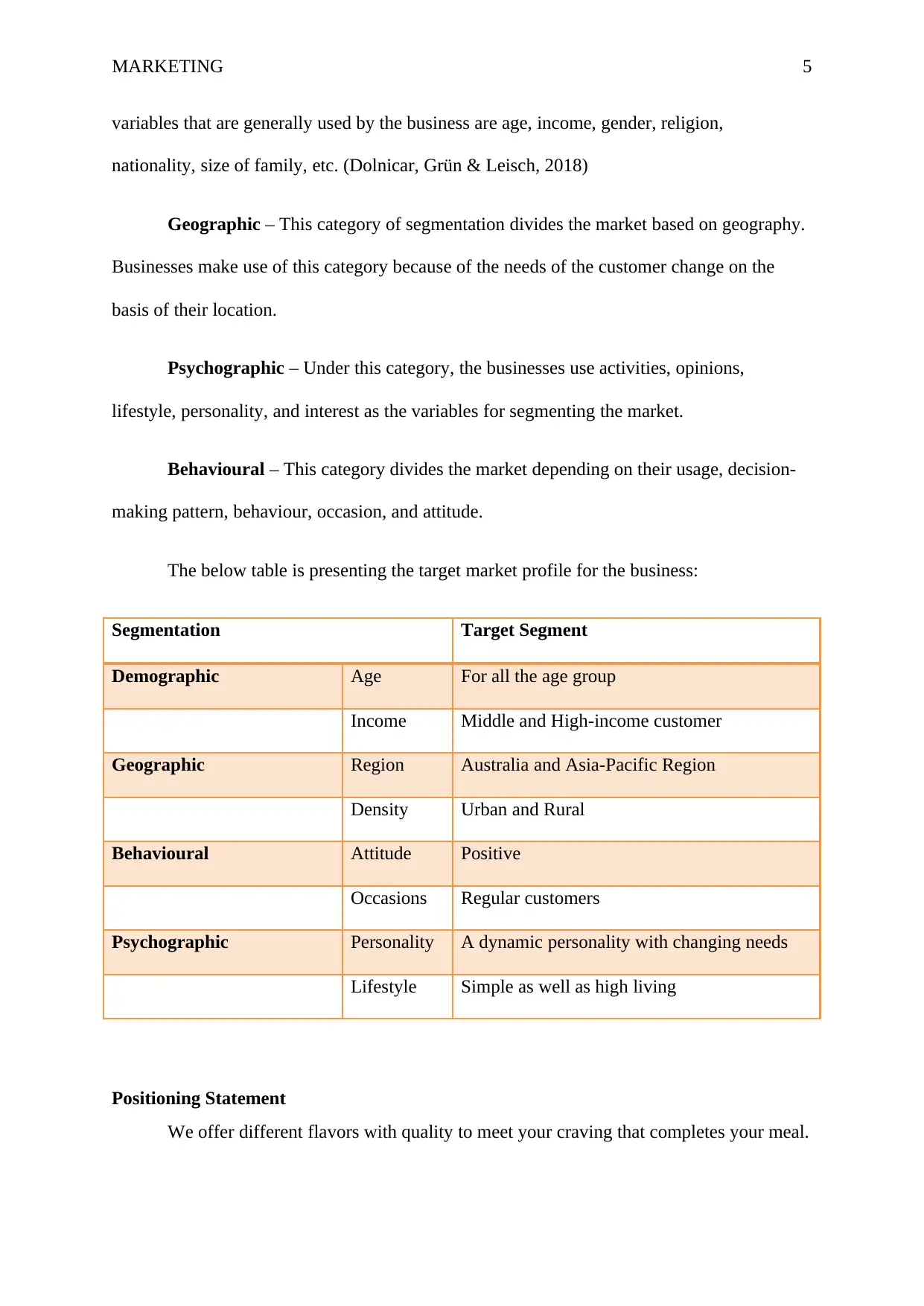
MARKETING 5
variables that are generally used by the business are age, income, gender, religion,
nationality, size of family, etc. (Dolnicar, Grün & Leisch, 2018)
Geographic – This category of segmentation divides the market based on geography.
Businesses make use of this category because of the needs of the customer change on the
basis of their location.
Psychographic – Under this category, the businesses use activities, opinions,
lifestyle, personality, and interest as the variables for segmenting the market.
Behavioural – This category divides the market depending on their usage, decision-
making pattern, behaviour, occasion, and attitude.
The below table is presenting the target market profile for the business:
Segmentation Target Segment
Demographic Age For all the age group
Income Middle and High-income customer
Geographic Region Australia and Asia-Pacific Region
Density Urban and Rural
Behavioural Attitude Positive
Occasions Regular customers
Psychographic Personality A dynamic personality with changing needs
Lifestyle Simple as well as high living
Positioning Statement
We offer different flavors with quality to meet your craving that completes your meal.
variables that are generally used by the business are age, income, gender, religion,
nationality, size of family, etc. (Dolnicar, Grün & Leisch, 2018)
Geographic – This category of segmentation divides the market based on geography.
Businesses make use of this category because of the needs of the customer change on the
basis of their location.
Psychographic – Under this category, the businesses use activities, opinions,
lifestyle, personality, and interest as the variables for segmenting the market.
Behavioural – This category divides the market depending on their usage, decision-
making pattern, behaviour, occasion, and attitude.
The below table is presenting the target market profile for the business:
Segmentation Target Segment
Demographic Age For all the age group
Income Middle and High-income customer
Geographic Region Australia and Asia-Pacific Region
Density Urban and Rural
Behavioural Attitude Positive
Occasions Regular customers
Psychographic Personality A dynamic personality with changing needs
Lifestyle Simple as well as high living
Positioning Statement
We offer different flavors with quality to meet your craving that completes your meal.
⊘ This is a preview!⊘
Do you want full access?
Subscribe today to unlock all pages.

Trusted by 1+ million students worldwide

MARKETING 6
Paraphrase This Document
Need a fresh take? Get an instant paraphrase of this document with our AI Paraphraser
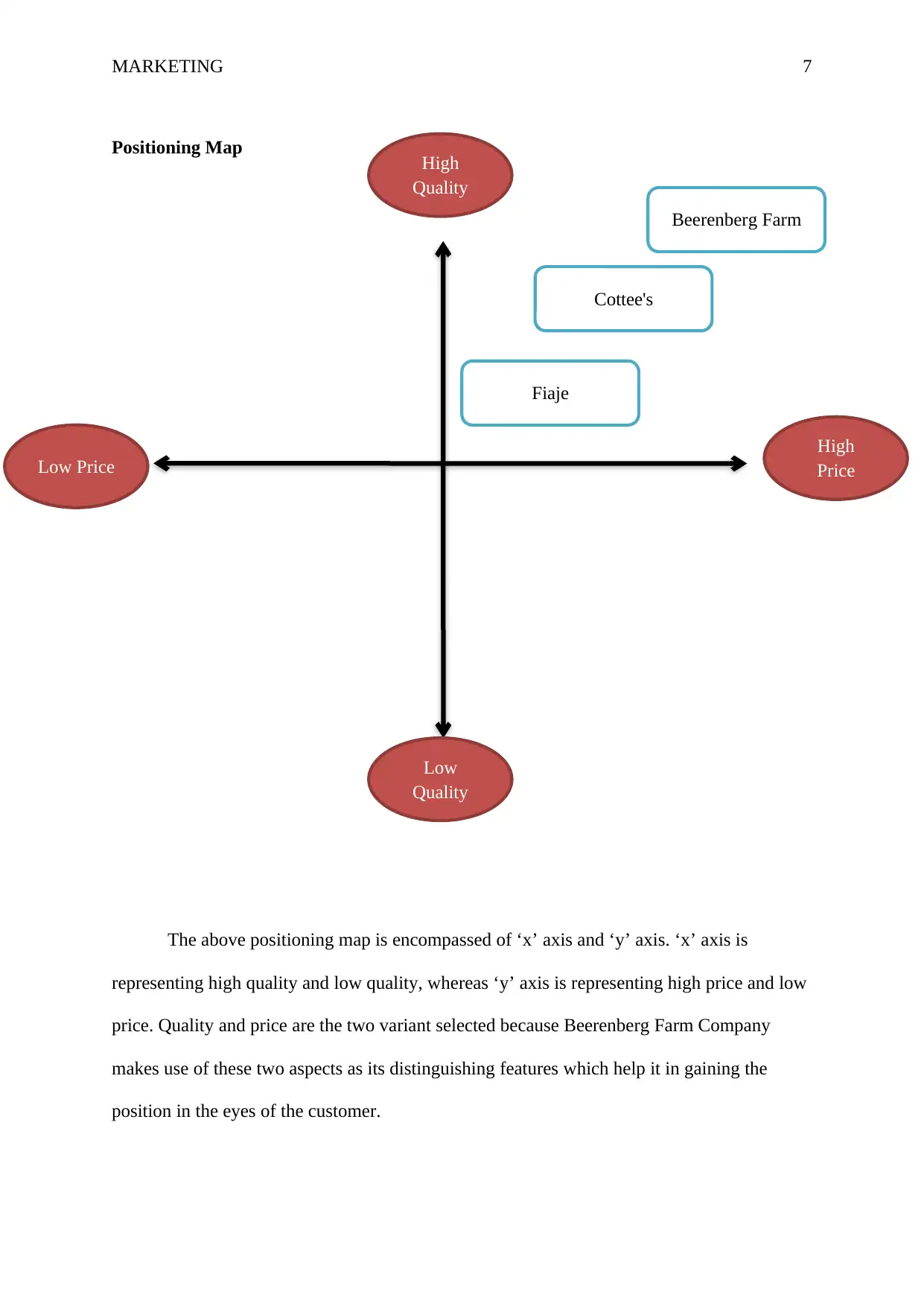
MARKETING 7
Positioning Map
The above positioning map is encompassed of ‘x’ axis and ‘y’ axis. ‘x’ axis is
representing high quality and low quality, whereas ‘y’ axis is representing high price and low
price. Quality and price are the two variant selected because Beerenberg Farm Company
makes use of these two aspects as its distinguishing features which help it in gaining the
position in the eyes of the customer.
High
Quality
High
PriceLow Price
Low
Quality
Beerenberg Farm
Fiaje
Cottee's
Positioning Map
The above positioning map is encompassed of ‘x’ axis and ‘y’ axis. ‘x’ axis is
representing high quality and low quality, whereas ‘y’ axis is representing high price and low
price. Quality and price are the two variant selected because Beerenberg Farm Company
makes use of these two aspects as its distinguishing features which help it in gaining the
position in the eyes of the customer.
High
Quality
High
PriceLow Price
Low
Quality
Beerenberg Farm
Fiaje
Cottee's
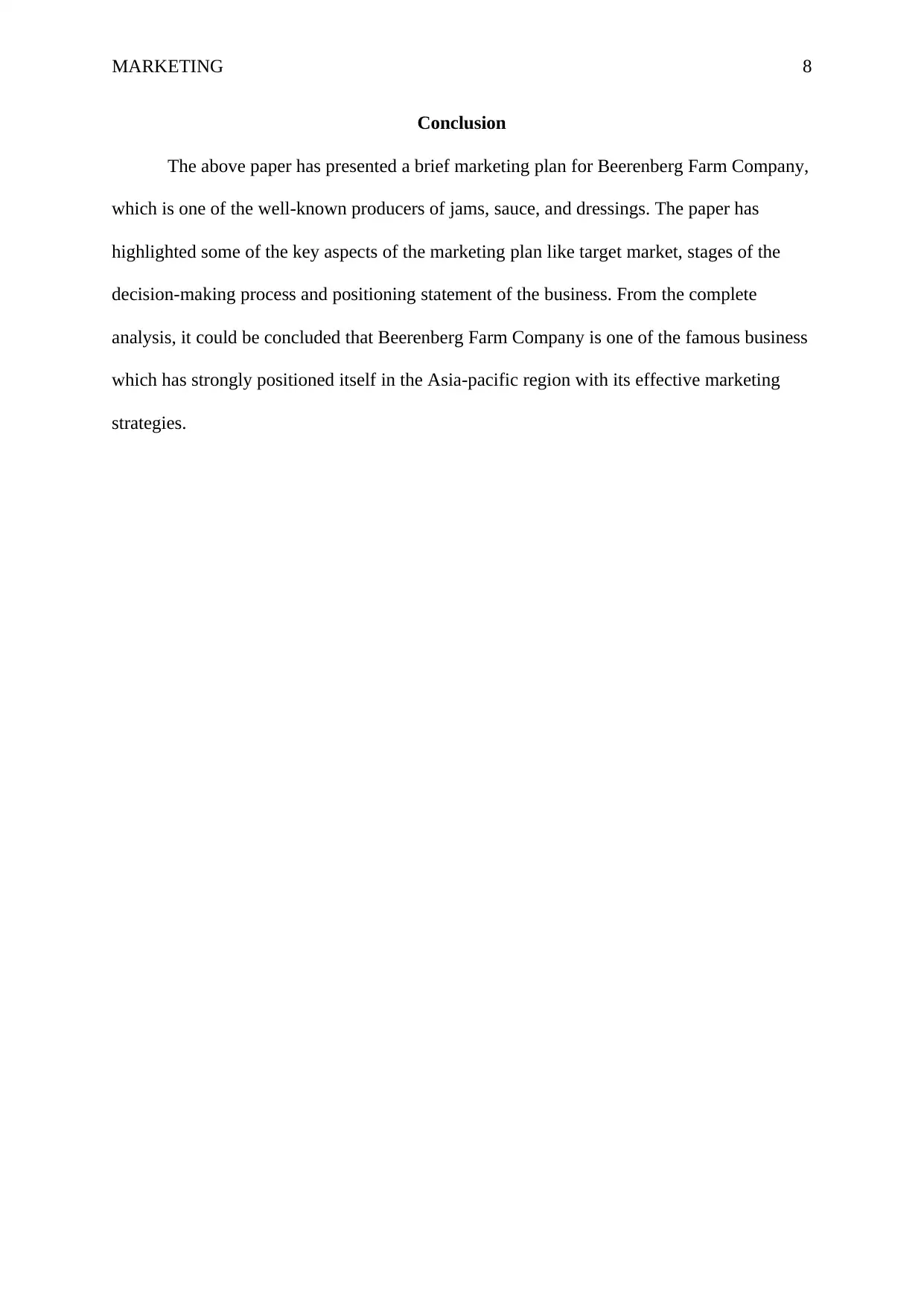
MARKETING 8
Conclusion
The above paper has presented a brief marketing plan for Beerenberg Farm Company,
which is one of the well-known producers of jams, sauce, and dressings. The paper has
highlighted some of the key aspects of the marketing plan like target market, stages of the
decision-making process and positioning statement of the business. From the complete
analysis, it could be concluded that Beerenberg Farm Company is one of the famous business
which has strongly positioned itself in the Asia-pacific region with its effective marketing
strategies.
Conclusion
The above paper has presented a brief marketing plan for Beerenberg Farm Company,
which is one of the well-known producers of jams, sauce, and dressings. The paper has
highlighted some of the key aspects of the marketing plan like target market, stages of the
decision-making process and positioning statement of the business. From the complete
analysis, it could be concluded that Beerenberg Farm Company is one of the famous business
which has strongly positioned itself in the Asia-pacific region with its effective marketing
strategies.
⊘ This is a preview!⊘
Do you want full access?
Subscribe today to unlock all pages.

Trusted by 1+ million students worldwide
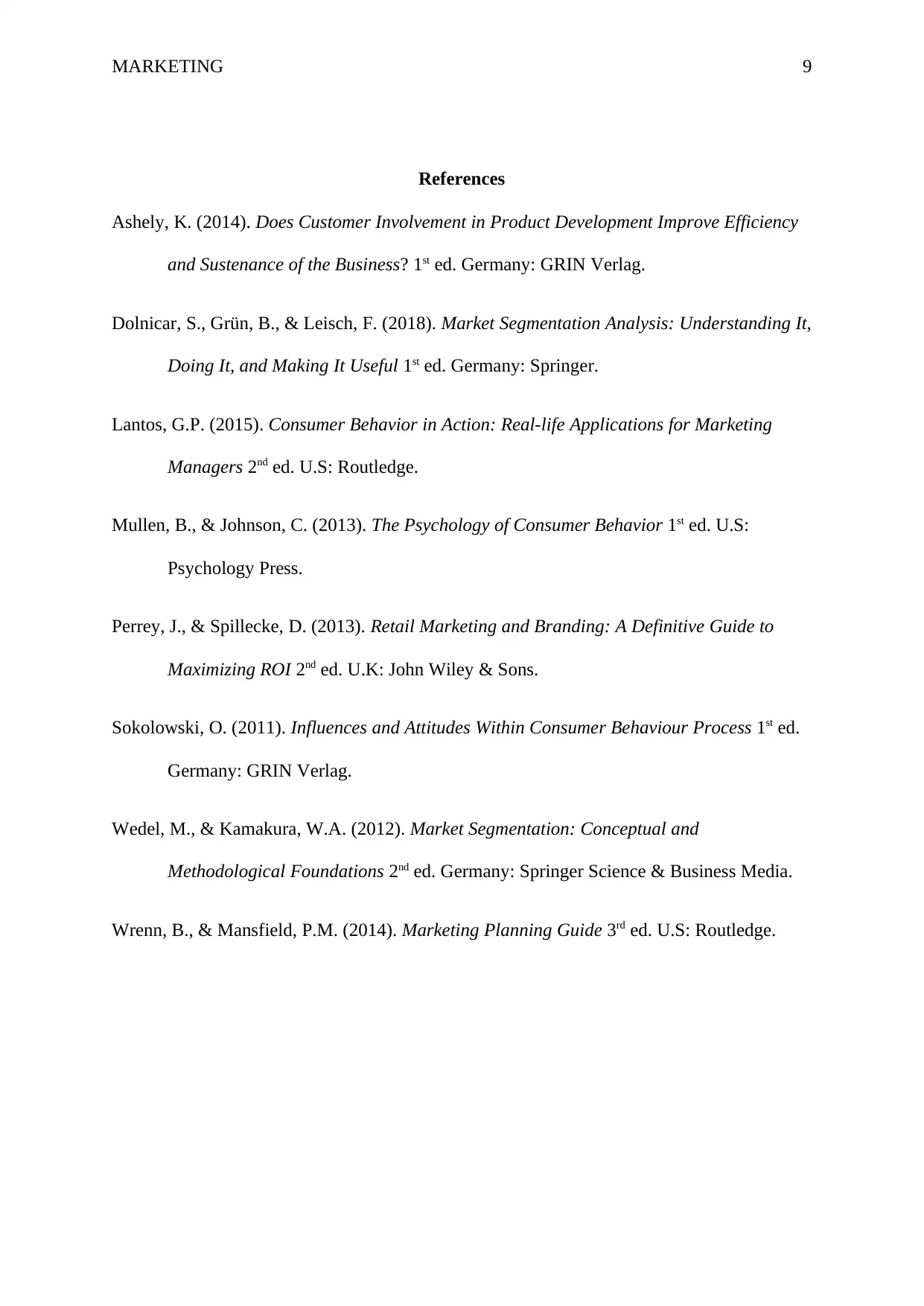
MARKETING 9
References
Ashely, K. (2014). Does Customer Involvement in Product Development Improve Efficiency
and Sustenance of the Business? 1st ed. Germany: GRIN Verlag.
Dolnicar, S., Grün, B., & Leisch, F. (2018). Market Segmentation Analysis: Understanding It,
Doing It, and Making It Useful 1st ed. Germany: Springer.
Lantos, G.P. (2015). Consumer Behavior in Action: Real-life Applications for Marketing
Managers 2nd ed. U.S: Routledge.
Mullen, B., & Johnson, C. (2013). The Psychology of Consumer Behavior 1st ed. U.S:
Psychology Press.
Perrey, J., & Spillecke, D. (2013). Retail Marketing and Branding: A Definitive Guide to
Maximizing ROI 2nd ed. U.K: John Wiley & Sons.
Sokolowski, O. (2011). Influences and Attitudes Within Consumer Behaviour Process 1st ed.
Germany: GRIN Verlag.
Wedel, M., & Kamakura, W.A. (2012). Market Segmentation: Conceptual and
Methodological Foundations 2nd ed. Germany: Springer Science & Business Media.
Wrenn, B., & Mansfield, P.M. (2014). Marketing Planning Guide 3rd ed. U.S: Routledge.
References
Ashely, K. (2014). Does Customer Involvement in Product Development Improve Efficiency
and Sustenance of the Business? 1st ed. Germany: GRIN Verlag.
Dolnicar, S., Grün, B., & Leisch, F. (2018). Market Segmentation Analysis: Understanding It,
Doing It, and Making It Useful 1st ed. Germany: Springer.
Lantos, G.P. (2015). Consumer Behavior in Action: Real-life Applications for Marketing
Managers 2nd ed. U.S: Routledge.
Mullen, B., & Johnson, C. (2013). The Psychology of Consumer Behavior 1st ed. U.S:
Psychology Press.
Perrey, J., & Spillecke, D. (2013). Retail Marketing and Branding: A Definitive Guide to
Maximizing ROI 2nd ed. U.K: John Wiley & Sons.
Sokolowski, O. (2011). Influences and Attitudes Within Consumer Behaviour Process 1st ed.
Germany: GRIN Verlag.
Wedel, M., & Kamakura, W.A. (2012). Market Segmentation: Conceptual and
Methodological Foundations 2nd ed. Germany: Springer Science & Business Media.
Wrenn, B., & Mansfield, P.M. (2014). Marketing Planning Guide 3rd ed. U.S: Routledge.
1 out of 10
Related Documents
Your All-in-One AI-Powered Toolkit for Academic Success.
+13062052269
info@desklib.com
Available 24*7 on WhatsApp / Email
![[object Object]](/_next/static/media/star-bottom.7253800d.svg)
Unlock your academic potential
Copyright © 2020–2025 A2Z Services. All Rights Reserved. Developed and managed by ZUCOL.





